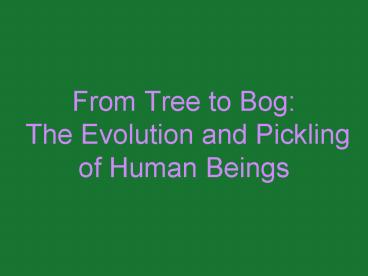From Tree to Bog: The Evolution and Pickling of Human Beings - PowerPoint PPT Presentation
1 / 25
Title:
From Tree to Bog: The Evolution and Pickling of Human Beings
Description:
... C. Migrations across Bering Straits. Basic Ideas. Ape Australopithacus ... Crossing of Bering Strait land bridge made possible by ice age that created huge ... – PowerPoint PPT presentation
Number of Views:67
Avg rating:3.0/5.0
Title: From Tree to Bog: The Evolution and Pickling of Human Beings
1
From Tree to Bog The Evolution and Pickling of
Human Beings
2
The Big Questions of Human Evolution
- What spurs the evolutionary process?
- How did humans gain cognitive powers?
- What motivated early human migration?
3
Background
- 4.5 billion B.C. Planet Earth formed
- 4.4 million B.C. Earliest known hominid
fossils - 3.2 million B.C. Australopithecus afarenis (
Lucy) - 2.5 million B.C. Homo habilis
- 1.8 million B.C. Homo erectus
- 100,000 B.C. First modern Homo sapiens
- 15,000 B.C. Migrations across Bering Straits
4
(No Transcript)
5
Basic Ideas
- Ape gt Australopithacus gt Homo
- Homo
- Habilis skillful
- Erectus Upright
- Sapien Wise
- Hominid having hominine features
- Bipedalism
- Human body proportions
- Loss of body hair
- Omnivory
- Tool-making
6
Lucy was a late Australopithecus found in
Africa. Early evidence of link between humans
and apes.
7
What causes evolution?
- Characteristics suited to environments
are passed on - Pressures from climate change causes adaption,
migration, and extinction
8
Case Study From Bipedalism to Cognitive Powers
- Australopithecus has small skeletal structure and
cranium - Bipedal but still very arboreal trees as
sources of food and refuge - Infant is self-sufficient very shortly after
birth - Experienced evolutionary stasis for 1.5 M.y.a.
which indicated stable environment and little
climate change
9
Climate change
- Ice Age 2.5 M.a. transformed habitats world-wide
- In Africa forested areas become dry grasslands
- Trees are less available, Australopithecus forced
to spend more time on ground
10
Results Australopithecus into Homo
- Development of bipedal skills in relation to
large predators and food sources - Mothers no longer required to climb, spend more
time caring for infant - High in utero brain growth rate extends into
post-natal period
11
Migration Related to Climate
- Homo skeleton found in Kenya tall linear
structure suited to long-distance travel and warm
weather spread to north-east Africa during warm
intervals - Short compact physiques and skeletal structures
of Neanderthals adapted to low temperatures and
aided survival - Crossing of Bering Strait land bridge made
possible by ice age that created huge glaciers
and lowered sea level
12
Travels of the First Humans
13
Muddy WatersQuestions about Bogs
- What are bogs?
- How are bogs formed?
- How do they preserve materials?
- What geological formations and materials do they
produce?
14
What are bogs?
- Bogs and fens are two forms of peatlands
- Peatlands are accumulations of peat
- Peat soil composed of partially decomposed dead
plants that accumulate in waterlogged areas - Peat is 90 water and 10 solid material
15
(No Transcript)
16
How were bogs formed?
- Bog formation began at the end of the last
glaciation about 100,000 years ago - Shallow lakes were left behind by retreating ice
- Major bog formations are found in the British
Isles, the Netherlands, Germany, Denmark,
Belgium, and Switzerland
17
(No Transcript)
18
The formation of a raised bog.
19
What do bogs produce?
- Rich and ancient habitats of biological diversity
- Carbon-rich peat (cut for fossil fuel)
- Lithification produces coal and clues to earth
history (Pennsylvanian formation)
20
How do bogs preserve materials?
- Acidic with a pH of 3.2 to 4.2, caused by
Sphagnum (bog mosses) - Prevents growth of micro-organisms that cause
decay of flora and fauna - Preserves human bodies, turning skin to leather
and preserving organs and skeleton
21
What bogs can tell us
- Plant and animal fossils give information about
community persistence, stability, and response to
major climate disruptions - Rock formations tell about climate (ie,
alternating wet-dry depositions) - Any biological or geological turnovers offer
evidence about climate change
22
(No Transcript)
23
Bodies in the Bog
24
(No Transcript)
25
Clues to the Past
Bodies can tell us about the habits, lifestyles,
and civilization of early humans, which can in
turn give us clues about past climate patterns

